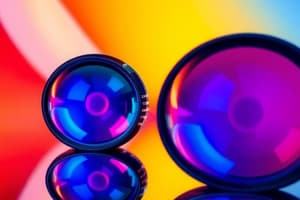Podcast
Questions and Answers
What is the role of reflection in mirrors and reflective surfaces?
What is the role of reflection in mirrors and reflective surfaces?
- To absorb light
- To refract light
- To send light back in the opposite direction (correct)
- To create shadows
What is the wave theory of light based on?
What is the wave theory of light based on?
- Oscillating electric and magnetic fields (correct)
- Absorption
- Particles
- Reflection only
What determines the behavior of light and the instruments needed to manipulate it?
What determines the behavior of light and the instruments needed to manipulate it?
- Density
- Wavelength and frequency (correct)
- Temperature
- Surface area
In what way does light interact with objects according to the wave theory of light?
In what way does light interact with objects according to the wave theory of light?
Why are mirrors considered essential in the construction of optical instruments?
Why are mirrors considered essential in the construction of optical instruments?
What is the function of lenses in optical instruments?
What is the function of lenses in optical instruments?
How do convex lenses differ from concave lenses?
How do convex lenses differ from concave lenses?
Which optical phenomenon is responsible for the bending of light as it passes through different media?
Which optical phenomenon is responsible for the bending of light as it passes through different media?
In optical instruments, what role do mirrors play alongside lenses?
In optical instruments, what role do mirrors play alongside lenses?
What is the primary function of optical instruments like telescopes and microscopes?
What is the primary function of optical instruments like telescopes and microscopes?
Flashcards are hidden until you start studying
Study Notes
Optics: Exploring the World of Light and Lenses
Optics, a field that lies at the heart of our understanding of light, has shaped the technologies we use every day. In this article, we'll delve into the fascinating world of optical instruments, lenses, refraction, and reflection, laying the foundation for further investigations into the intricate dance of light and matter.
Optical Instruments
Optical instruments, such as telescopes, microscopes, and cameras, rely on lenses and mirrors to manipulate light and enable us to see the world in new ways. These tools have expanded our understanding of the natural world and facilitated advancements in science, engineering, and medicine.
Lenses
A lens is a key component of optical instruments, focusing or dispersing light waves to form images. Lenses are typically constructed from glass or plastic and are classified as either convex (converging) or concave (diverging). Convex lenses cause light to converge, forming a real image behind the lens, while concave lenses disperse light, producing a virtual image in front of the lens.
Refraction
Refraction, the bending of light as it passes through substances with different optical properties, is a fundamental principle in optics. Think of it as light taking a detour when it moves from one medium to another, like a car navigating a winding road. Refraction plays a crucial role in shaping our perception of the world, as it determines how light enters our eyes and forms images on our retinas.
Reflection
Reflection occurs when light encounters a smooth surface and bounces back in the opposite direction. Mirrors and reflective surfaces, such as the polished metal on signal reflectors or the surface of a puddle, rely on reflection to send light back into our eyes. Reflection is also essential in understanding how light interacts with objects and materials, as well as in the construction of optical instruments like mirrors.
Light Waves
Light is an electromagnetic waveform, consisting of oscillating electric and magnetic fields. The interaction of light with matter and its behavior in optical instruments are best explained using the wave theory of light. According to this theory, light travels in waves, bending when it passes through different media and interacting with objects in its path. Light has a wavelength, frequency, and speed, and these properties determine its behavior and the instruments needed to manipulate it.
In the pursuit of understanding these fundamental concepts, we've developed countless applications of optics, from the everyday camera phone to the cutting-edge technology of quantum computing. Optics continues to be a vibrant field of study, and its discoveries have the potential to shape the future of science, technology, and life as we know it.
Studying That Suits You
Use AI to generate personalized quizzes and flashcards to suit your learning preferences.




